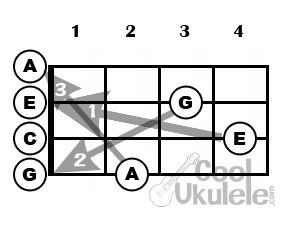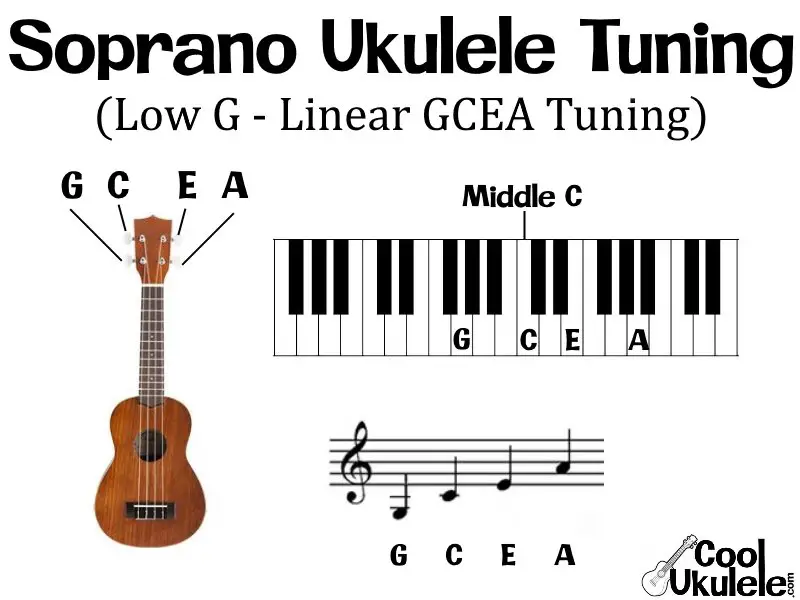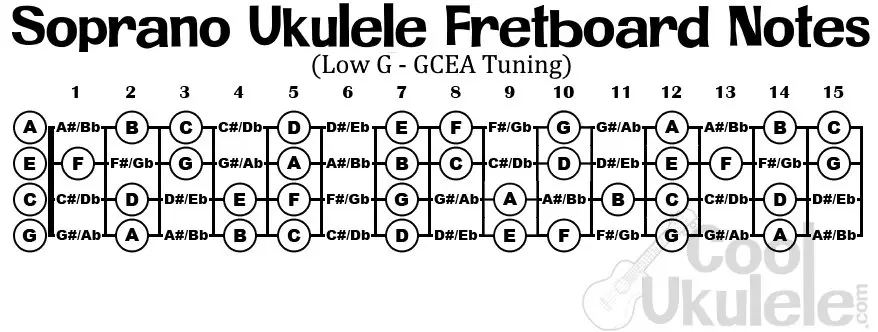
The Soprano ukulele is the smallest of the 4 traditional ukulele sizes (soprano, concert, tenor, and baritone). Only the relatively newer sopranino and sopranissimo sizes are smaller.
Due to its popularity, it’s also what many consider the quintessential ukulele size.
So you’ve bought a soprano ukulele, but now you need to get the darned thing tuned?
The Soprano Ukulele is typically tuned to GCEA re-entrant tuning, however, it can also less commonly be tuned to Low G GCEA tuning or ADF#B tuning (D tuning).

This image shows which string is tuned to which note, and those notes on the piano/keyboard and music staff.
These GCEA standard notes could more specifically be identified as G4, C4, E4, and A4, which identifies that they are contained in the 4th octave of the octaves typically used in music (the octave containing middle C).
And here are the same pitches in video format.
Read on for more soprano ukulele tuning information!
Contents
- How to Tune a Soprano Ukulele by Ear with Reference Note
- How do you Tune a Soprano Ukulele with a Tuner?
- Can I Tune My Soprano Ukulele with Low G Tuning?
- Soprano Ukulele Tuning Frequencies (Hz)
- Why is the Soprano Uke traditionally tuned with a High G String?
- How do I tune a Soprano Banjo Ukulele?
- What are the Notes of the Fretboard of a Tuned Soprano Uke?
- What are the Common Chords on a Tuned Soprano Ukulele?
- Soprano Ukulele Scale Length
- Conclusion
How to Tune a Soprano Ukulele by Ear with Reference Note
To tune a soprano uke to itself, by ear, with a reference note, you first have to start out with a middle C reference note.
This could be an electric keyboard, tuning fork, an audio file, etc.
Now that you have this note, loosen all your strings so that they are clearly lower than the desired tightness.
Now tune the thickest string, 3rd from bottom, to the reference middle C note by slowly tightening it and plucking it while simultaneously playing the reference note until the pitches match.
You can tell the pitches match because they’ll sound identical and there will be no “warble” in the sound when both are played together.
The next steps are displayed in this image. (Note the 3 steps are numbered in the arrows.)

Now, hold down this string at the 4th fret and pluck it while tightening and plucking the next string down (E string) until the pitches match. (Arrow 1 in the image.)
Next, hold down this E string at the 3rd fret to get the pitch for he G string (top string). Tighten the top string to this pitch. (Arrow 2 in the image.)
Finally, get the pitch for the A string by plucking the top string (G string) at the 2nd fret. (Arrow 3 in the image.)
Congrats, you’re ready to start strumming!
How do you Tune a Soprano Ukulele with a Tuner?
Here’s a video demonstrating how to tune your ukulele with a clip-on electronic tuner
A clip-on tuner reads the vibration of the uke when a string is plucked.
It then displays the closest note to the pitch of the vibration and whether the pitch is higher, lower, or exactly on the desired frequency of the displayed note.
If the tuner shows the pitch of the plucked string is lower, you tighten the string with the appropriate tuning part at the head of the uke.
If the pitch of the plucked string is higher, you loosen the string.
It’s pretty straight forward.
Can I Tune My Soprano Ukulele with Low G Tuning?
Although not as common as on the tenor uke, the soprano ukulele can absolutely be tuned with Low G tuning using G3 instead of G4 for the top note.

Note that this will require a different G string than for High G tuning, and strings are usually sold in sets. (But ukulele strings are normally pretty inexpensive.)
Here’s an image showing the steps to tune a uke to low G tuning by ear, to itself, with a reference note for the low G.

Use the same basic steps as above, except start with the Low G string from reference, and work your way up to the higher strings.
For a detailed discussion of advantages and disadvantages of these 2 tuning systems, check out our High G vs. Low G ukulele tuning article.
Soprano Ukulele Tuning Frequencies (Hz)
Here’s a table of the frequencies used for tuning a soprano ukulele to high G GCEA tuning.
| Uke String | Tuning Frequency |
|---|---|
| G4 (High G) | 392 Hz |
| C4 | 261.63 (often rounded to 262) Hz |
| E4 | 329.63 (often rounded to 330) Hz |
| A4 | 440 Hz |
And here’s the corresponding table for Low G Soprano ukulele tuning.
| Uke String | Tuning Frequency |
|---|---|
| G3 (Low G) | 196 Hz |
| C4 | 261.63 (often rounded to 262) Hz |
| E4 | 329.63 (often rounded to 330) Hz |
| A4 | 440 Hz |
As an aside, notice that the high G frequency (392 Hz) is exactly double the low G frequency (196 Hz).
This is because these notes are exactly one octave apart and octaves are based on multiples/division of 2.
So a pitch with twice the frequency will be one octave higher.
And a pitch with half the frequency will be one octave lower.
But this is a little outside the scope of this article.
Why is the Soprano Uke traditionally tuned with a High G String?
The purpose of High G tuning is to give the uke a brighter sound when strumming.
To explain further:
On down strums, the last note of the strum will be the A string (highest string).
On up strums, the last note of the strum will be the G string (second highest string).
Because these high strings are at the end of the strums, the overall effect is a brighter, more “happy” tone than if the strings were arranged in linear order.
How do I tune a Soprano Banjo Ukulele?
A soprano banjo ukulele has all the same tuning options/traditions as a standard wood-body soprano.
This means high G, GCEA re-entrant tuning is also the traditional tuning for a banjo soprano uke.
And other options like low G tuning, D tuning (ADF#B), etc. are also options for the soprano banjo uke.

For further information, check out our in-depth banjo ukulele tuning article.
What are the Notes of the Fretboard of a Tuned Soprano Uke?
This is a diagram of the fingerboard notes of the soprano uke tuned to high G, GCEA tuning.

The diagram shows the note all the way up to the 15th fret, but at the 12th fret the notes repeat (open strings = 12th fret, etc.).
This is because the 12th fret is one octave higher than the open strings, and all notes which are octaves higher or lower use the same letter names.
And here’s the fretboard chart for Low G GCEA tuning.

What are the Common Chords on a Tuned Soprano Ukulele?
Here’s a chart of the common chords on the GCEA tuned soprano uke.
Chord types include major, 6th, 7th, 8th, major 7th, minor, minor 6th, minor 7th, minor 9th, suspended 2nd, suspended 4th, augmented, and diminished.
The columns represent the different chord types, and the rows the different root notes, as labelled.

Soprano Ukulele Scale Length
The scale length of the soprano uke is 13 to 14 inches.
This is the distance from the saddle of the uke to the nut.
The saddle is the part of the ukulele on the body that holds the strings, and the nut is the part on the neck which holds the strings in their correct position.
Conclusion
Well there you have it.
You have several tuning methods, types, and information, as well as some material to get you started with playing (fretboard notes and common chords).
So, hopefully your soprano ukulele is now tuned and ready to be played.
Happy strumming!

There are some basic beginner guitar chords that you should know. Open chords are a great way to get started, but they require that you have the most basic knowledge of guitar technique. You can learn how to play open chords by taking them from the guitar tab.
I am uke player. I have a banjoele, concert, concert electric, soprano, a resonator concert and a tenor with a “low g”
thank you for
all if your explanations and especially the cord charts.